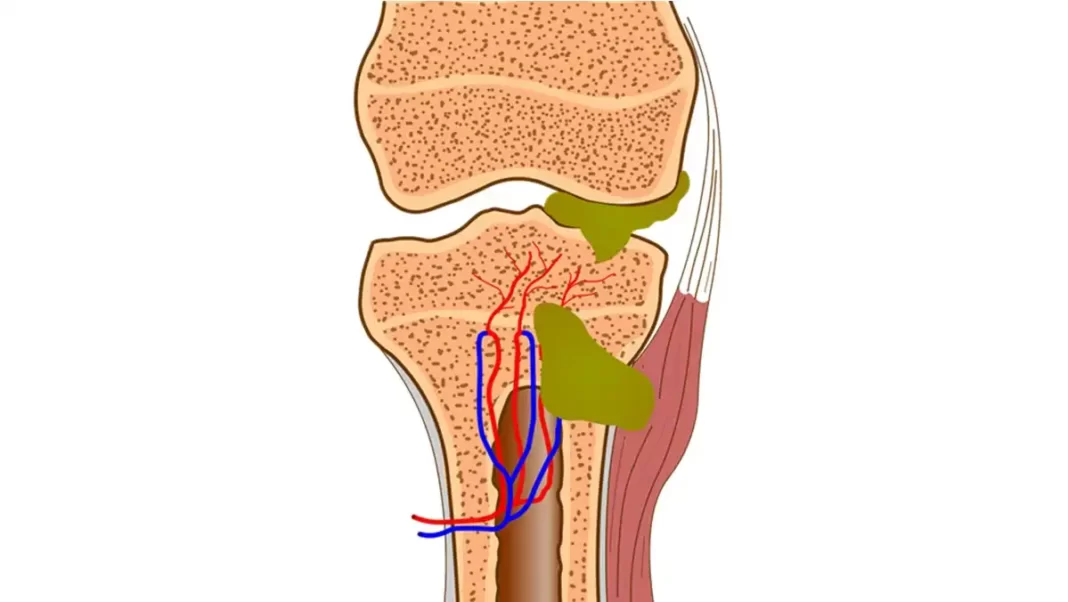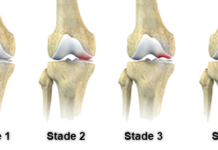Introduction
Osteomyelitis, a severe inflammation of the bone usually caused by a bacterial infection, is a complex medical condition that has marked the history of medicine. This disorder can affect people of all ages and has been studied extensively to better understand its mechanisms, causes, and treatment options.
This serious condition occurs when bacteria enter the bone, triggering an inflammatory response that can lead to severe bone damage. The pathogens that cause osteomyelitis can be introduced into the bone through a variety of means, such as open wounds, surgical procedures, severe skin infections, or even through the bloodstream. Long bones, such as the femur and tibia, are most commonly affected by this condition, although other parts of the skeleton can also be affected.
The history of understanding osteomyelitis goes back centuries. In the past, this disease was often fatal due to the lack of medical knowledge and proper diagnostic tools. However, over time, advances in medical science have allowed a better understanding of this condition, its causes and underlying mechanisms.
Symptoms of osteomyelitis can vary depending on the severity of the infection. Common signs include severe bone pain, local inflammation, fever, and chills. Patients with osteomyelitis may also experience general fatigue and loss of appetite. Diagnosis of this disease is often based on imaging tests such as X-rays, CT scans, or MRIs, as well as blood tests to check for infections.
Treatment of osteomyelitis is complex and may involve a combination of medical and surgical approaches. Antibiotics are usually given to fight infection, and surgery may be needed to drain infected areas or remove damaged bone tissue. In some cases, bone grafts may be needed to promote regeneration of healthy bone tissue.
Prompt treatment of osteomyelitis is essential to avoid serious complications such as widespread infections, abscesses, or growth disorders in children. Management of this disease requires a multidisciplinary approach involving physicians, surgeons, microbiologists, and other health professionals.
In conclusion, osteomyelitis remains a complex medical condition that has evolved over time thanks to advances in medicine. Understanding its mechanisms and treatment options is crucial to improve clinical outcomes and quality of life for those affected by this debilitating disease. Continued research in this area will undoubtedly help refine treatment strategies and provide better hope for patients facing this dreaded disease.
Osteomyelitis in history
Osteomyelitis, a severe inflammation of the bone often due to a bacterial infection, has left a significant mark on the history of medicine. The first descriptions of this condition date back to antiquity, although its true infectious nature was understood later during the evolution of medical knowledge.
Early medical writings describe symptoms related to bone infections, but it was difficult to distinguish osteomyelitis from other conditions that affect the bones. Significant advances in understanding this disease occurred in the 19th century. Advances in surgical techniques and early X-rays allowed physicians to more accurately diagnose osteomyelitis and develop more targeted treatment approaches.
In the early 20th century, osteomyelitis was often associated with serious infections and significant medical complications. Mortality rates were high due to the lack of effective antibiotics to combat bacterial infections. The discovery of penicillin in the 1920s marked a turning point in the treatment of osteomyelitis, as it offered a powerful weapon against the pathogens that caused this disease.
During World War I and II, osteomyelitis was frequently observed in wounded soldiers. Bone infections following war injuries have led to increased interest in research and development of new treatment strategies. Antibiotics have been widely used to control infections and have significantly improved clinical outcomes.
Over the decades, medical advances have continued to influence the understanding and management of osteomyelitis. Modern imaging techniques, such as magnetic resonance imaging (MRI) and computed tomography (CT), have allowed for earlier and more accurate diagnosis. Antibiotic protocols have also been refined to specifically target the pathogens responsible for the infection.
Today, although osteomyelitis can still pose medical challenges, continued advances in surgery, medical imaging, and antibiotics have significantly improved treatment prospects. Ongoing research in this field aims to develop more personalized and innovative approaches to better treat this condition and minimize long-term complications. Thus, the history of osteomyelitis illustrates how successive medical advances have transformed the perception, diagnosis, and treatment of this disease over the centuries.
Causes
Osteomyelitis is usually caused by a bacterial infection, although fungal or viral infections may also be responsible in some cases. Bacteria are the most common pathogens associated with this condition. Here are some of the main causes of osteomyelitis:
- Bacteria: Staphylococcus aureus is the bacteria most commonly associated with osteomyelitis. This bacteria can reach the bone through a variety of means, such as open wounds, skin infections, or bloodstream infections that spread to the bone.
- Fungal Infections: Although less common than bacterial infections, fungal infections, such as those caused by the fungus Candida or Aspergillus, can lead to osteomyelitis, especially in people with weakened immune systems.
- Viral Infections: Viral infections are rarely the direct cause of osteomyelitis, but certain serious viral infections, such as human immunodeficiency virus (HIV) infection, can increase the risk of secondary infections, including osteomyelitis.
- Traumatic Injuries: Open fractures, penetrating wounds, or traumatic injuries can create an entry route for bacteria, making it easier for osteomyelitis to develop.
- Orthopedic Surgery: Orthopedic surgical procedures, especially those involving prosthetics or bone implants, may increase the risk of osteomyelitis due to the possibility of introducing bacteria during surgery.
- Bloodborne Infections: A common source of osteomyelitis is the spread of infection through the bloodstream. Bacteria in the blood can colonize the bones, especially in people with circulatory problems or untreated systemic infections.
- Diabetes: People with diabetes are at increased risk of osteomyelitis due to decreased blood circulation and susceptibility to infections.
- Immune Compromised: Medical conditions or treatments that weaken the immune system, such as chemotherapy, autoimmune diseases, or HIV, can make a person more susceptible to infections, including osteomyelitis.
Symptoms
- Bone Pain: Pain in the affected bone is one of the most common symptoms. The pain may be constant and may worsen with movement or pressure on the affected area.
- Swelling: The affected bone and surrounding tissues may become swollen due to inflammation associated with the infection.
- Fever: Fever may occur, particularly in cases of acute osteomyelitis. The presence of fever often indicates a systemic response of the body to the infection.
- Skin Redness: The skin over the infected area may become red and warm to the touch, reflecting underlying inflammation.
- Joint Stiffness: If osteomyelitis affects a joint, joint stiffness may develop, limiting the range of motion of the affected joint.
- General Fatigue: General fatigue may occur, particularly in the presence of a severe infection that mobilizes the body’s resources to fight the bacterial invasion.
- Irritability in Children: Children with osteomyelitis may have symptoms such as irritability, fever, and difficulty using the affected limb.
- Lameness: When osteomyelitis affects a lower limb, a limp may develop due to pain and discomfort associated with walking.
- Weight Loss: Unintentional weight loss may occur due to the systemic inflammatory response caused by the infection.
- General Symptoms of Infection: In addition to bone-specific symptoms, general symptoms of infection may occur, such as chills, headache, and night sweats.
Pathophysiology
The pathophysiology of osteomyelitis involves a complex series of immune and inflammatory responses of the body to bacterial or, in some cases, fungal or viral infection. Understanding the underlying mechanisms of the disease is crucial to developing effective treatment strategies. Here is an overview of the main steps in the pathophysiology of osteomyelitis:
- Introduction of the Pathogen: Osteomyelitis usually occurs when bacteria enter the bone. This can occur following traumatic injury, orthopedic surgery, hematogenous spread from another source of infection, or through the lymphatic system.
- Initial Inflammatory Response: When bacteria enter the bone, an immediate inflammatory response is triggered. Immune cells, such as neutrophils and macrophages, migrate to the infected area in an attempt to destroy the pathogens.
- Abscess Formation and Necrosis: Bacteria multiply and often form pockets of infection, called abscesses, within the bone. This can lead to bone necrosis, a destruction of bone tissue due to the deprivation of blood supply caused by the infection.
- Immune System Activation: The immune system reacts systemically, releasing inflammatory mediators such as cytokines. This leads to systemic symptoms such as fever, fatigue, and loss of appetite.
- Bone Sequestra Formation: Dead areas of bone, called sequestra, may form inside the infected bone. These sequestra may be difficult to treat with antibiotics because of poor blood flow to these areas.
- Hematogenous Spread: In some cases, osteomyelitis can result from an infection elsewhere in the body that spreads through the bloodstream to the bone. This is often seen in children.
- Chronic Response: Osteomyelitis may progress to a chronic phase, characterized by persistent inflammation and scarring. Symptoms may become less pronounced, but the infection persists.
- Complications: If osteomyelitis is not treated adequately, it can lead to serious complications, such as spread of infection to other parts of the body, pathologic fractures, or growth defects in children.
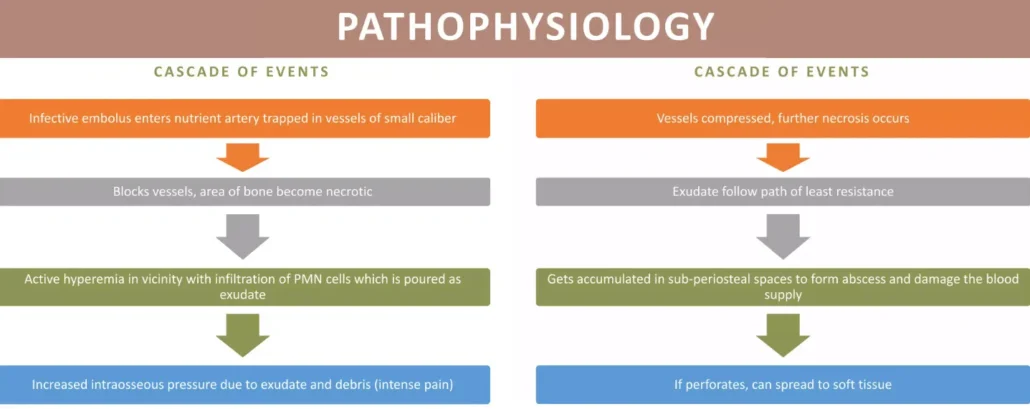
Initial Event:
The process begins with an infective embolus entering the nutrient artery, where it becomes trapped in small-caliber vessels within the bone. This obstruction disrupts blood flow, leading to localized ischemia (lack of oxygen).
Vessel Blockage and Necrosis:
The blockage causes the surrounding bone tissue to become necrotic (dead) due to insufficient blood supply. This is a key turning point where tissue damage begins.
Inflammatory Response:
The infection triggers active hyperemia, increasing blood flow to the affected region. Polymorphonuclear (PMN) cells infiltrate the area, releasing exudate, a fluid containing immune cells and debris, which raises intraosseous pressure, causing intense pain.
Progression of Damage:
As pressure builds, the compressed vessels exacerbate necrosis. The exudate then follows the path of least resistance, accumulating in subperiosteal spaces, forming abscesses that further damage the bone’s blood supply.
Potential Spread:
If untreated, the infection can perforate the periosteum, spreading to surrounding soft tissues, leading to systemic infection or chronic osteomyelitis.
This cascade emphasizes the need for early diagnosis and intervention to prevent irreversible bone damage. Treatment typically involves antibiotics, drainage of abscesses, and in severe cases, surgical debridement. Understanding these stages is critical for effective management of osteomyelitis and avoiding long-term complications.
Classification
- Classification according to etiology:
- Infectious Osteomyelitis: Caused by pathogens such as bacteria, fungi, or viruses. Bacteria are the most common cause.
- Non-infectious osteomyelitis: May result from vascular disorders, inflammatory disorders or autoimmune diseases.
- Classification by location:
- Hematogenous Osteomyelitis: The infection comes from a distant source, often through the bloodstream, and usually affects areas rich in bone marrow, such as the metaphyses of long bones.
- Contiguous Osteomyelitis : The infection spreads from an adjacent area, such as a skin infection or open wound.
- Classification according to chronology:
- Acute Osteomyelitis: Rapid development of infection, often with severe symptoms.
- Chronic Osteomyelitis: A persistent infection that can last for weeks, months, or even years.
- Classification according to severity:
- Superficial Osteomyelitis: Affects the outer layer of the bone, called the periosteum.
- Deep Osteomyelitis: Involves the entire bone, including the bone marrow.
- Specific classification according to population:
- Pediatric Osteomyelitis: More common in children, often associated with hematogenous infections.
- Osteomyelitis in Adults: May result from hematogenous infections or postoperative complications.
Hematogenous osteomyelitis
Hematogenous osteomyelitis is a specific form of bone infection that is characterized by bone inflammation caused by the spread of infectious bacteria through the bloodstream. Although this condition is more common in children, it can also affect adults, especially those with a history of intravenous drug use.
The main pathogens involved in hematogenous osteomyelitis in adults are Staphylococcus aureus and streptococci. The route of infection often occurs through the use of contaminated hypodermic needles, mainly associated with intravenous drug administration. In the context of drug use, injected substances are sometimes mixed with other agents, thus increasing the risk of contamination by foreign particles.
The infectious process begins when bacteria present on the skin or introduced by contaminated needles enter the bloodstream. Once in the blood, these pathogens can travel to various parts of the body. In the case of hematogenous osteomyelitis, the bacteria have a particular affinity for bones, especially the spine and pelvis, where they establish a focus of infection.
Clinical manifestations of hematogenous osteomyelitis in adults include symptoms such as fever, bone pain, stiffness, and sometimes local signs of inflammation. Radiographic images may reveal characteristic signs such as osteolysis, marked by progressive destruction of bone tissue, peripheral sclerosis forming a bony rim, and a periosteal reaction in the form of successive layers similar to an “onion skin.”
Diagnosis of hematogenous osteomyelitis is based on a combination of laboratory tests, medical imaging, and evaluation of clinical symptoms. Treatment typically involves the administration of antibiotics tailored to the identified pathogens, combined with surgical procedures if necessary to drain accumulations of pus and stabilize the affected area.
In children
Acute hematogenous osteomyelitis in children is a serious medical condition, and the majority of cases are found in this vulnerable population. This form of osteomyelitis is often caused by the introduction of pathogenic bacteria into the bone through the bloodstream. Some of the most common pathogens associated with this condition in children include Staphylococcus aureus, Streptococcus pyogenes, and Haemophilus influenzae. These microbes can trigger a severe inflammatory reaction in the bone, leading to acute symptoms such as severe pain, local inflammation, fever, and chills.
The most common sites affected by pediatric osteomyelitis are those characterized by rapid growth and increased risk of trauma. At the top of the list, the distal femur is the most affected site, followed by the proximal tibia, proximal femur, proximal humerus, and distal radius. This hierarchy of decreasing importance is explained by the dynamic nature of bone growth in children and the increased propensity for trauma in these specific regions.
The unique physiology of the metaphyseal veins in children also plays a crucial role in the development of osteomyelitis. The metaphyseal veins in children are naturally larger, leading to a significant slowdown in blood flow in these regions. This creates an environment conducive to bacterial colonization, thereby promoting the implantation of blood-borne microorganisms. This condition makes traumatized areas more susceptible to bacterial infection, contributing to the increased prevalence of acute hematogenous osteomyelitis in children.
Diagnosis of osteomyelitis in children often relies on imaging techniques such as X-rays, CT scans, or MRIs, combined with blood tests to detect inflammatory markers. Treatment usually involves a combination of antibiotics to clear the infection and, in some severe cases, surgery to drain the infected areas.
In adults
Hematogenous osteomyelitis in adults is a less common condition, characterized by bone inflammation caused by the introduction of infectious bacteria, including Staphylococcus aureus and streptococci, into the bloodstream. The main cause of this form of osteomyelitis is intravenous drug use, where pathogens are carried from the skin and injected through potentially dirty hypodermic needles.
A worrying aspect of this situation is that injected drugs are often “cut”, that is, mixed with other substances, which increases the risk of contamination by foreign particles. This complex process creates an environment conducive to infection, and although it can establish itself anywhere in the body, it has a particular affinity for the spine and pelvis.
In the initial stage of infection, several clinical manifestations can be observed, including osteolysis, characterized by the progressive destruction of bone tissue. This destruction is often accompanied by peripheral sclerosis, where the bone margin undergoes a sclerosing reaction, forming a bony rim.
In addition, the periosteal response often takes the form of an “onion skin” structure, illustrating the layered response of the periosteum to infection. This complex periosteal response is the body’s attempt to contain and fight infection, but it also contributes to the morphologic changes seen in radiographic images.
It is crucial to emphasize that, although hematogenous osteomyelitis in adults is less common than in children, it remains a serious condition that requires prompt and appropriate medical management. Treatment usually includes the administration of antibiotics targeting the causative pathogens, often associated with surgical procedures to drain pus collections and stabilize the affected area.
Osteomyelitis resulting from direct inoculation of bacteria
Posttraumatic osteomyelitis, a feared complication following severe injuries, has become more common in children than haematogenous osteomyelitis, which was historically less common in this population. This may be attributed to a change in injury profile, with posttraumatic incidents such as puncture wounds, road traffic accidents or high-impact collisions resulting in complex and comminuted fractures.
Severe trauma, particularly from puncture wounds or open fractures, places bones at increased risk for infection by introducing debris such as metal, soil, and clothing fragments into the wound. These foreign objects provide a breeding ground for bacterial growth, including staphylococci and streptococci, pathogens commonly associated with posttraumatic osteomyelitis.
The first crucial step in the treatment of post-traumatic osteomyelitis is meticulous wound cleaning. Removal of foreign debris and disinfection of the area are essential to reduce the risk of persistent bacterial infection. In parallel, early administration of appropriate antibiotic treatment is essential to control the infection and prevent its spread.
If the traumatic injury is accompanied by a fracture, it becomes imperative to immobilize the fractured fragments. Immobilization promotes adequate vascularization, which is essential for optimal bone healing. Without adequate immobilization, blood flow can be compromised, hampering the body’s ability to effectively treat infected and inflamed tissues.
Post-traumatic osteomyelitis, as a complication of severe injuries, requires proactive and coordinated management. Surgical interventions may sometimes be necessary to drain abscesses or remove necrotic tissue. Close monitoring is also crucial to assess response to treatment, adjust antibiotics if necessary, and detect any potential complications.
Complications of surgery, although rare, can include problems such as postoperative infections, excessive bleeding or problems related to anesthesia. This is why a multidisciplinary approach, involving orthopedists, infectious disease specialists and other healthcare professionals, is essential to ensure comprehensive and appropriate care for each case.
Pathogenesis
The initiation of infection in adult hematogenous osteomyelitis presents crucial anatomical features, particularly at the level of the metaphysis of long bones, with a marked predominance at the lower end of the femur and the upper end of the tibia.
The metaphysis, which is the growth region of long bones, has looped metaphyseal blood vessels. This particular configuration slows down local blood flow and creates an environment conducive to stagnation. The metaphyseal blood vessels, instead of following a linear trajectory, make a U-turn to become venous channels.
This change in direction of the metaphyseal arteries causes stasis of blood flow, thus generating an accumulation of blood in this specific region. This accumulation, often referred to as a “blood lake,” creates a favorable context for the deposition and proliferation of bacteria. Blood stasis in this metaphyseal area provides an ideal environment for pathogens, initially introduced into the bloodstream, to attach and colonize the bone tissue.
Accumulation of bacteria in the “blood lake” is a critical starting point for osteomyelitis infection. Pathogens can then proliferate and trigger a local inflammatory response, leading to characteristic bone lesions such as osteolysis, peripheral sclerosis, and onion-skin reaction of the periosteum.
Understanding this sequence of events related to the pathogenesis of hematogenous osteomyelitis in the metaphysis of long bones is essential to guide diagnosis and treatment. The specificity of the metaphyseal vascular architecture provides a fertile ground for the establishment of infection and underlines the importance of rapid and targeted medical intervention to prevent severe complications associated with this bone condition.
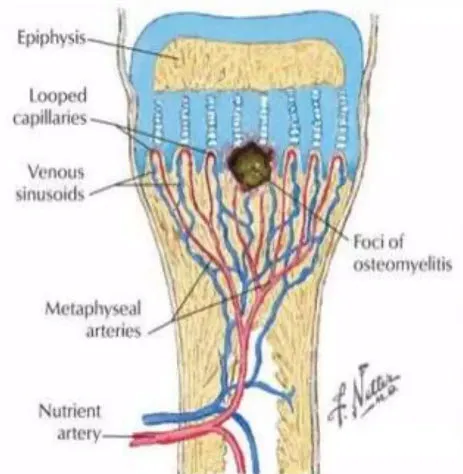
Bone Vascularity:
Long bones are richly supplied with blood through the nutrient artery, metaphyseal arteries, and venous sinusoids. These vessels ensure the delivery of oxygen and nutrients essential for bone growth and repair. Looped capillaries and venous sinusoids create a slow flow in the metaphyseal region, making it a common site for infections.
Foci of Osteomyelitis:
In osteomyelitis, bacteria or pathogens reach the bone via the bloodstream, direct injury, or adjacent infections. The slow circulation in the metaphyseal region allows pathogens to lodge and proliferate. The resulting infection leads to inflammation, necrosis, and abscess formation. The epiphyseal area in growing bones may remain unaffected due to its separate blood supply.
Clinical Significance:
The rich vascular network enables infection to spread rapidly, complicating treatment. Symptoms include localized pain, swelling, redness, and systemic signs like fever. If untreated, osteomyelitis can lead to chronic bone damage, sepsis, or deformity.
Early diagnosis and treatment with antibiotics or surgical intervention are critical to prevent irreversible bone damage and restore function. This detailed understanding of bone vascularity helps explain why osteomyelitis predominantly affects specific regions of the bone.
Bacterial seeding in the metaphysis of long bones is the starting point of the cascade of events leading to the formation of an osteomyelitis focus. This bacterial presence triggers a local inflammatory reaction, causing tissue necrosis in the metaphysis and resulting in the formation of a metaphyseal abscess.
As the abscess develops, intramedullary pressure gradually increases. This increase in intramedullary pressure plays a crucial role in the process of drainage of pus from the metaphysis. Under this increased pressure, the pus finds an escape route through the bone cortex, heading towards the subperiosteal space.
The escape of pus under the periosteum causes a lifting of this protective membrane of the bone tissue. This lifting of the periosteum is associated with an innate response of the body which results in new bone formation. Each time the periosteum is lifted, an osteogenic reaction occurs, characterized by the formation of bone tissue in response to the infection.
This periosteal reaction, often observed about 7 to 10 days after the onset of symptoms, is the body’s attempt to contain the infection and restore bone integrity. The formation of new bone contributes to the peripheral sclerosis seen in radiographic images, representing a protective and adaptive response to the ongoing infection.
In summary, the dynamic process that begins with bacterial seeding in the metaphysis evolves towards the formation of a metaphyseal abscess, with a local inflammatory reaction leading to tissue necrosis. The subsequent increase in intramedullary pressure promotes the escape of pus, the lifting of the periosteum and the repeated formation of bone tissue, thus participating in the complex immune and adaptive response of the body to osteomyelitis.

Initial Site of Infection:
The infection begins in the periosteum, the outermost layer of the bone, typically due to the spread of bacteria through the bloodstream or an open wound. At this stage, inflammation occurs, causing localized swelling and pain.
Spread to the Bone:
As the infection progresses, it infiltrates deeper into the bone, reaching the epiphyseal line in growing bones. A section of bone, known as the sequestrum (dead bone), forms due to compromised blood flow and tissue death. The infection also causes pus formation, which may escape into surrounding tissues, creating further inflammation.
Formation of Abscess:
If untreated, the infection leads to the development of a subperiosteal abscess, where pus collects beneath the periosteum. The abscess blocks blood supply, causing further necrosis and bone destruction. New bone, called involucrum, may form around the infected area as a protective response, but it often traps the infection.
This progression underscores the need for early diagnosis and treatment of osteomyelitis to prevent severe complications. Medical management typically includes antibiotics, drainage of abscesses, and in severe cases, surgical removal of infected bone tissue. Prompt attention can help restore healthy bone function and prevent chronic infection.
In the setting of chronic osteomyelitis, the sequestrum, which is a mass of necrotic bone isolated from the bloodstream, is a privileged site for infectious organisms. These organisms, equipped with proteolytic enzymes, undertake a destructive action on the involucrum, a bony structure that forms around the sequestrum as a defense mechanism of the body. Their enzymatic activity creates openings in the involucrum, known as the cloaca.
Cloacae are openings or passages formed by the action of proteolytic enzymes of infectious organisms. These openings allow pus, which has accumulated around the sequestrum, to escape from the bone. The pus thus released finds its way through the cloacae, exiting the affected bone.
This complex process of cloaca formation and pus drainage has important clinical implications. The pus, now outside the bone, seeks a route of escape through the surrounding tissues. As a result, openings appear in the skin, creating what is clinically known as a sinus.
Sinuses are abnormal passages that form between infected tissues and the skin surface, serving as drainage routes for pus. These sinuses are one of the distinctive clinical features of chronic osteomyelitis. Visually, they often appear as small skin openings from which pus can drain.
This formation of cloacae, the drainage of pus through these openings, and the presence of sinuses are key elements in understanding the evolution of osteomyelitis to a chronic phase. These clinical manifestations require extensive medical management, often combining surgical interventions to drain pus collections and remove sequestra, as well as targeted antibiotic treatment to control persistent infection.
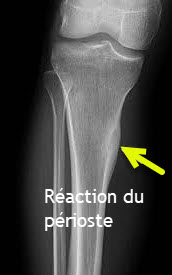
Risk factors
- Injuries or surgical procedures: Fractures or surgical procedures, especially those involving orthopedic implants, increase the risk of osteomyelitis by creating entry routes for bacteria.
- Systemic infections: Acute or chronic infections in other parts of the body, such as the respiratory tract or urinary tract, can increase the likelihood of pathogens spreading to the bones through the bloodstream.
- Immune system compromise: Individuals with weakened immune systems, whether due to diseases such as HIV, immunosuppressive medications, or chronic medical conditions, are more likely to develop osteomyelitis.
- Diabetes: People with diabetes are more vulnerable to infections due to their compromised immune system and impaired blood circulation, which increases the risk of osteomyelitis.
- Intravenous drug use: Direct introduction of bacteria into the bloodstream through intravenous drug use significantly increases the risk of osteomyelitis, especially in adults.
- Age: Infants and the elderly are more vulnerable to osteomyelitis. In infants, the disease may result from complications of bloodstream infections. In the elderly, the increased prevalence may be due to decreased immune function.
- Vascular diseases: Vascular disorders, such as arteriosclerosis, can compromise blood flow to the bones, creating an environment favorable to infection.
- Rheumatic diseases: Conditions such as rheumatoid arthritis or lupus, which affect the joints and connective tissues, can increase the risk of osteomyelitis.
- Skin trauma: Skin wounds or ulcers, especially those related to sports injuries, ulcers, or surgical wounds, create potential entry points for bacteria.
- Excessive use of alcohol or tobacco: Excessive alcohol consumption and smoking can weaken the immune system, increasing susceptibility to infections, including osteomyelitis.
Complications
- Intraosseous abscess: Uncontrolled infection can lead to abscess formation within the affected bone. These abscesses can be difficult to treat and require repeated surgical procedures for drainage.
- Bone sequestra formation: In chronic cases, bone necrosis can lead to the formation of sequestra, pieces of dead bone isolated from the bloodstream. These sequestra may persist despite treatment, often requiring surgery to remove them.
- Bone defects and deformities: Severe osteomyelitis can result in destruction of bone tissue, leading to structural defects and deformities. This can compromise limb functionality and require reconstructive surgical procedures.
- Recurrent infections: Despite successful initial treatment, osteomyelitis can sometimes lead to relapses, particularly in individuals with persistent risk factors or underlying medical problems.
- Widespread infection (sepsis): In severe cases, the infection can spread beyond the initial site, leading to life-threatening sepsis. This can affect other organs and systems in the body.
- Growth failure in children: In children, osteomyelitis can disrupt normal bone growth, leading to limb length discrepancies and other orthopedic complications.
- Septic arthritis: The infection can spread to nearby joints, causing joint inflammation called septic arthritis. This can lead to loss of mobility and other joint complications.
- Neurological complications: If the infection reaches the spine, it can compress the spinal cord and lead to neurological complications, including sensory and motor disturbances.
- Infection of surrounding soft tissues: Infection can spread to nearby soft tissues, leading to cellulitis and skin complications.
- Systemic inflammatory responses: Osteomyelitis can trigger systemic inflammatory responses, resulting in symptoms such as fever, severe fatigue, and general malaise.
- Chronicity of infection: Osteomyelitis can become a chronic infection, resistant to standard treatments, making disease management more complex.
- Mobility restrictions: Severe bone injuries and resulting deformities can lead to significant limitations in mobility and functionality, affecting the quality of life of those affected.
- Psychological impact: Chronic complications of osteomyelitis, such as persistent pain, dependence on medical treatments, and physical limitations, can have a significant psychological impact, leading to stress, anxiety, and sometimes depression.
- Vascular problems: The infection can damage surrounding blood vessels, leading to vascular complications, such as thrombosis or blood circulation problems.
- Osteoarthritis: Joint damage associated with osteomyelitis can progress to osteoarthritis, causing degradation of joint cartilage and persistent joint symptoms.
- Renal complications: In severe cases with sepsis, the kidneys may be affected, leading to potentially severe renal complications.
- Development of antibiotic resistance: Prolonged use of antibiotics can lead to the development of drug resistance, making treatment of the infection more difficult.
- Reduced bone quality: Frequent surgery and destruction of bone tissue can lead to reduced bone quality, increasing the risk of fractures.
- Growth delays in children: Osteomyelitis can disrupt normal bone growth in children, leading to growth delays and orthopedic abnormalities.
- Economic implications: Long-term management of osteomyelitis, with repeated medical and surgical treatments, can result in high costs for patients and health systems.
Radiographic signs
- Osteolysis: Osteolysis, or loss of bone, is often seen as a darkened area on X-rays. This area indicates destruction of bone tissue due to infection.
- Peripheral sclerosis: Around the affected area, there may be an increase in bone density, called peripheral sclerosis. This represents the body’s attempt to strengthen bone tissue in response to the infection.
- Periosteal “onion skin” reaction: A periosteal reaction may appear as a series of overlapping layers of bone, similar to an “onion skin.” This results from the periosteum’s inflammatory response to the infection.
- Intraosseous abscess formation: Areas of radiolucency may indicate the presence of intraosseous abscesses. These pockets of pus may require surgical drainage.
- Cloacae and Sinuses: X-ray images can sometimes reveal the presence of cloacae, openings in the bony involucrum, as well as skin sinuses. These signs indicate the body’s attempt to drain pus from the bone.
- Altered bone density: Changes in bone density, such as areas of sparseness or fragmentation, may indicate abnormalities associated with osteomyelitis.
- Structural defects and deformities: Radiographs may show structural defects, disturbances in bone geometry, and deformities resulting from destruction of bone tissue.
- Joint abnormalities: When osteomyelitis affects a joint, joint changes may be seen on X-rays, indicating problems in the joint area.
- Widening of joint spaces: When the infection spreads to a joint, widening of the joint spaces may be detected on X-ray images.
- Distant bone reactions: Sometimes osteomyelitis can induce bone reactions distant from the infected area, which can also be detected on X-rays.
- Bone sequestra: Sequestra appear as radiolucent areas, indicating the presence of dead or necrotic bone tissue. They may present as discrete masses, often surrounded by an area of peripheral sclerosis, showing the body’s attempt to contain the infection. Sequestra formation may require surgical removal, thus helping to control the infection.
- Changes in bone density: Infection may cause a decrease in bone density in affected areas, which is seen as darker (radiolucent) areas on X-rays. These areas of bone sparseness indicate destruction of bone tissue due to the activity of infectious agents.
Conclusion
In conclusion, osteomyelitis, a bone infection often caused by bacteria, can lead to serious complications if not treated effectively. Risk factors, such as injuries, systemic infections, and underlying medical conditions, increase the likelihood of developing this condition. Complications of osteomyelitis include intraosseous abscess formation, bone sequestra, structural defects, mobility limitations, and psychological impacts.
In chronic cases, cloacae may form, allowing pus to escape and creating cutaneous sinuses, distinctive clinical features of chronic osteomyelitis. Complications are not limited to the infected site, but can also affect other organs and systems of the body, highlighting the importance of careful medical management.
Early prevention, accurate diagnosis, and adequate therapeutic intervention are crucial to minimize the risk of complications. The use of targeted antibiotics, surgery to drain abscesses and remove necrotic tissue, and management of underlying risk factors are key components of treatment.
Furthermore, consideration of the psychological, social and economic implications for individuals affected by osteomyelitis highlights the importance of a holistic care approach. Close collaboration between different health professionals is essential to ensure comprehensive care and improve the quality of life of patients affected by this complex disease.
References
- Schmitt SK. Osteomyelitis . Infect Dis Clin North Am. 2017 Jun;31(2):325-338. [ PubMed ]2.
- Lew DP, Waldvogel FA. Osteomyelitis . N Engl J Med. 1997 Apr 03;336(14):999-1007. [ PubMed ]3.
- Rubin RJ, Harrington CA, Poon A, Dietrich K, Greene JA, Moiduddin A. The economic impact of Staphylococcus aureus infection in New York City hospitals. Emerg Infect Dis. 1999 Jan-Feb;5(1):9-17. [ PMC free article ] [ PubMed ]4.
- Kremers HM, Nwojo ME, Ransom JE, Wood-Wentz CM, Melton LJ, Huddleston PM. Trends in the epidemiology of osteomyelitis : a population-based study, 1969 to 2009. J Bone Joint Surg Am. 2015 May 20;97(10):837-45. [ PMC free article ] [ PubMed ]5.
- Hatzenbuehler J, Pulling TJ. Diagnosis and management of osteomyelitis . Am Fam Physician. 2011 Nov 01;84(9):1027-33. [ PubMed ]6.
- Zimmerli W. Clinical practice. Vertebral osteomyelitis . N Engl J Med. 2010 Mar 18;362(11):1022-9. [ PubMed ]7.
- Berbari EF, Kanj SS, Kowalski TJ, Darouiche RO, Widmer AF, Schmitt SK, Hendershot EF, Holtom PD, Huddleston PM, Petermann GW, Osmon DR, Infectious Diseases Society of America 2015 Infectious Diseases Society of America (IDSA) Clinical Practice Guidelines for the Diagnosis and Treatment of Native Vertebral Osteomyelitis in Adults. Clin Infect Dis. 2015 Sep 15;61(6):e26-46. [ PubMed ]8.
- Lam K, van Asten SA, Nguyen T, La Fontaine J, Lavery LA. Diagnostic Accuracy of Probe to Bone to Detect Osteomyelitis in the Diabetic Foot: A Systematic Review. Clin Infect Dis. 2016 Oct 01;63(7):944-8. [ PubMed ]9.
- Lima AL, Oliveira PR, Carvalho VC, Cimerman S, Savio E., Diretrizes Panamericanas para el Tratamiento de las Osteomielitis e Infecciones de Tejidos Blandos Group. Recommendations for the treatment of osteomyelitis . Braz J Infect Dis. 2014 Sep-Oct;18(5):526-34. [ PubMed ]10.
- Calhoun JH, Manring MM. Adult osteomyelitis . Infect Dis Clin North Am. 2005 Dec;19(4):765-86. [ PubMed ]11.
- Dutra LMA, Melo MC, Moura MC, Leme LAP, De Carvalho MR, Mascarenhas AN, Novaes MRCG. Prognosis of the outcome of severe diabetic foot ulcers with multidisciplinary care. J Multidiscip Healthc. 2019;12:349-359. [ PMC free article ] [ PubMed ]

